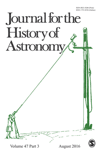
JOURNAL FOR THE HISTORY OF ASTRONOMY
Scope & Guideline
Exploring the Cosmos of Historical Thought
Introduction
Aims and Scopes
- Historical Analysis of Astronomical Practices:
The journal focuses on the historical methods and practices of astronomy, examining instruments, observations, and data interpretation from different time periods and cultures. - Interdisciplinary Approaches:
It encourages interdisciplinary research, integrating history, philosophy, cultural studies, and science, to provide a holistic understanding of how astronomical knowledge has evolved. - Cultural and Societal Impacts:
The journal explores the cultural and societal implications of astronomical discoveries and theories, including how they affected societal beliefs, practices, and knowledge systems. - Global Perspectives:
Research published often includes global perspectives, highlighting contributions from various cultures in the history of astronomy, including Islamic, Chinese, and European influences. - Analysis of Historical Texts and Manuscripts:
There is a strong emphasis on the analysis of historical texts and manuscripts related to astronomy, shedding light on the transmission of knowledge and the evolution of astronomical thought.
Trending and Emerging
- Impact of Modern Technology on Historical Astronomy:
There is an increasing interest in how modern technological advancements, such as digital imaging and data analysis, are applied to historical astronomical research, enhancing our understanding of past practices. - Cultural Astronomy:
A noticeable trend towards cultural astronomy is emerging, with studies exploring the intersections between astronomy and cultural practices, beliefs, and rituals across different societies. - Interdisciplinary Studies of Astronomy:
Research that employs interdisciplinary approaches, combining history, philosophy, and science, is becoming more prominent, as scholars seek to provide a richer context for understanding the development of astronomical knowledge. - Women in Astronomy:
There is a growing trend in exploring the contributions of women in the history of astronomy, highlighting their roles and impact in a historically male-dominated field. - Astronomical Observatories and Their Histories:
An increase in studies dedicated to the history and development of astronomical observatories reflects a trend toward understanding the institutional and infrastructural aspects of astronomy.
Declining or Waning
- Astrology and Its Historical Context:
Although astrology has historically been a significant area of study in relation to astronomy, recent publications show a decline in the focus on astrology as a legitimate field of inquiry, likely due to the increasing differentiation between astronomy and astrology. - Ancient Astronomical Methods:
There has been a noticeable decrease in studies solely focused on ancient astronomical methods, as the journal shifts towards more contemporary analyses and the integration of modern scientific perspectives. - Narrow Regional Studies:
Research that focuses exclusively on narrow regional studies, particularly those limited to specific local histories of astronomy, appears to be declining, with a trend toward broader, more comparative studies.
Similar Journals

HISTORY OF SCIENCE
Connecting the Dots Between Science and Its Historical RootsHISTORY OF SCIENCE, published by SAGE PUBLICATIONS LTD, stands as a pivotal journal in the domain of historical studies, with a focus on the development and evolution of scientific thought and practice throughout history. With an ISSN of 0073-2753 and an E-ISSN of 1753-8564, this journal is recognized for its commitment to high-quality research, as evidenced by its categorization in the Q2 quartile for History and Q3 for History and Philosophy of Science in 2023. Spanning a converged history from 1962 to 2024, the journal serves as an essential platform for scholars, providing in-depth analyses and discussions that foster a deeper understanding of the interplay between science and its historical context. As a well-regarded source in the field, it ranks #140 out of 1760 in Arts and Humanities History and maintains a commendable 92nd percentile ranking, highlighting its influence and reach among researchers and professionals alike. Although not an Open Access journal, it remains accessible to students, scholars, and practitioners in the field, bridging the past and present of scientific inquiry.

Tijdschrift voor Rechtsgeschiedenis-Revue d Histoire du Droit-The Legal History Review
Exploring the Evolution of JurisprudenceTijdschrift voor Rechtsgeschiedenis-Revue d'Histoire du Droit-The Legal History Review is a prestigious academic journal published by BRILL, situated in the Netherlands. With a rich publication history dating back to 1920, this journal serves as a vital resource for scholars and practitioners in the fields of legal history and historical legal studies. Although it currently holds a Q4 ranking in both the History and Law categories, making it a developing journal within its domain, it has been a significant contributor to the discourse surrounding legal traditions, historical context, and the evolution of jurisprudence. Operating within the convergence years of 1920 to 2024, the journal aims to foster scholarly dialogue and promote interdisciplinary research. While it does not offer open access, the unique insights provided within its pages are invaluable for researchers, students, and professionals seeking to enhance their understanding of legal history. By focusing on critical analyses and evidence-based research, the Legal History Review inspires a robust engagement with the past to inform contemporary legal practices and policies.
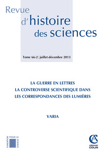
Revue d Histoire des Sciences
Advancing Understanding Through Historical Context.Revue d'Histoire des Sciences is a distinguished academic journal published by Armand Colin, focusing on the intricate interplay of history and philosophy within the sciences. Since its inception in 1973, the journal has served as a vital platform for researchers, scholars, and students interested in exploring the historical dimensions of scientific development. With an ISSN of 0151-4105 and an E-ISSN of 1969-6582, this journal is recognized within the academic community, achieving a modest 2023 Scopus ranking of Q3 in History and Philosophy of Science, positioning it within the 41st percentile of its category. The journal offers a prestigious space for rigorous discourse, critical analysis, and innovative research aimed at advancing our understanding of the scientific enterprise's past. While it operates under a traditional access model, the ongoing commitment to rich scholarly content ensures that the contributions will resonate with those dedicated to the intersections of history, science, and philosophy, providing insights into how historical context shapes scientific inquiry and advancement.

Global Intellectual History
Unraveling the Tapestry of Intellectual HistoryGlobal Intellectual History is an esteemed journal published by Taylor & Francis Ltd, dedicated to exploring the intricate interconnections between global cultures, historical narratives, and intellectual thought from 2016 to 2024. With an ISSN of 2380-1883 and an E-ISSN of 2380-1891, this journal holds a Q2 category ranking in multiple fields, including Arts and Humanities, Cultural Studies, and History, indicating its reputable standing within the academic community. Although not openly accessible, it caters significantly to scholars and students interested in the multifaceted dimensions of intellectual history, offering critical insights and fresh perspectives that enhance our understanding of global narratives. With a Scopus ranking placing it in the upper percentiles across various categories, Global Intellectual History serves as an essential resource for advancing research and scholarly discourse in its field.

EXPERIMENTAL ASTRONOMY
Transforming Observations into UnderstandingEXPERIMENTAL ASTRONOMY, published by Springer, stands as a pivotal journal in the fields of Astronomy and Astrophysics as well as Space and Planetary Science. With an impressive Scopus ranking and a Q2 category as of 2023, the journal is recognized for its impactful contributions to experimental techniques and observations in astronomy. Covering a broad spectrum of topics from cosmic phenomena to planetary exploration, it serves as a vital platform for researchers, professionals, and students to disseminate and discuss innovative ideas and findings. The journal has evolved through various convergence years since its inception in 1989 and continues to thrive, fostering an environment for academic pursuit and collaboration. Though not an open-access journal, its rigorous peer-review process ensures high-quality publications that are essential for advancing the scientific community's understanding of the universe.
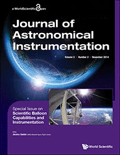
Journal of Astronomical Instrumentation
Exploring New Horizons in Astronomical ResearchThe Journal of Astronomical Instrumentation, published by WORLD SCIENTIFIC PUBL CO PTE LTD, is a pioneering peer-reviewed journal that has established itself as a vital outlet for the dissemination of research in the fields of astronomy and astrophysics, as well as in instrumentation technologies. Since its inception in 2012, this international journal has provided a platform for researchers and practitioners to share their findings, innovations, and insights pertaining to astronomical tools and techniques. With an esteemed Q3 categorization in both Astronomy and Astrophysics and Instrumentation for 2023, it ranks within the top tier of journals in these disciplines, demonstrating its impact and relevance in the scholarly community. Covering a broad range of topics that encompass the design, development, and application of astronomical instruments, the journal also emphasizes technological advancements that enhance observational capabilities. Researchers, professionals, and students alike will find this journal an invaluable resource for staying abreast of current trends and breakthroughs in the field of astronomical instrumentation.

Cuadernos de Historia del Derecho
Bridging Past and Present in Legal History.Cuadernos de Historia del Derecho, published by the esteemed Universidad Complutense de Madrid, serves as a vital platform for scholars and practitioners within the field of legal history. This journal, bearing the ISSN 1133-7613 and E-ISSN 1988-2521, focuses on enhancing the understanding of legal developments, practices, and institutions through a rigorous historical lens. While currently not classified as open access, the journal aims to bridge gaps in legal scholarship, providing valuable insights and fostering an academic community dedicated to exploring the evolution of legal systems. With an increasing impact factor attributed to its scholarly contributions, Cuadernos de Historia del Derecho stands out as a key resource for researchers, professionals, and students alike, who are keen on delving into the intricate narratives that have shaped contemporary law. Located in the heart of Madrid, the journal continues to engage a global audience dedicated to the critical analysis of historical legal frameworks.

CIAN-Revista de Historia de las Universidades
Delving into the Roots of University HistoryCIAN-Revista de Historia de las Universidades, published by UNIV CARLOS III MADRID, INST ANTONIO NEBRIJA ESTUDIOS UNIV, is an esteemed academic journal dedicated to exploring the historical contexts and developments of universities, particularly within the Spanish landscape. With an ISSN of 1139-6628 and an E-ISSN of 1988-8503, the journal has established itself as a significant contributor to scholarship, representing the convergence of educational and historical studies from 2019 to 2024. Particularly noteworthy is its 2023 positioning, where it holds a prestigious Q1 ranking in History and Q4 in Education, indicative of its commitment to high-quality research. Positioned within the mid-range percentile of its fields—ranked 742 out of 1760 in History and 1371 out of 1543 in Education—CIAN serves as a vital resource for researchers, professionals, and students aiming to deepen their understanding of the historical evolution of universities. Although it currently does not feature open access options, the journal provides invaluable insights and academic rigor, making it an important point of reference for those interested in the intersections of history and education.
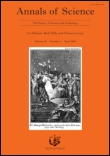
ANNALS OF SCIENCE
Connecting Past Discoveries with Future PhilosophiesANNALS OF SCIENCE, published by Taylor & Francis Ltd, is a pivotal journal in the field of the History and Philosophy of Science, as evidenced by its Q3 categorization and a respectable Scopus rank of 99 out of 223, placing it in the 55th percentile among its peers. With a rich history dating back to its initial publication in 1936, the journal has made significant contributions to scholarly discourse, providing a platform for researchers and academics to explore the intricate connections between scientific developments and philosophical inquiries. The journal's commitment to rigorous academic research ensures that it remains a vital resource for professionals, educators, and students dedicated to understanding the evolution of scientific thought. Although it operates under traditional subscription models, the journal's importance in shaping modern scientific discussions cannot be overstated, making it an essential read for those engaged in the multifaceted study of science's history and philosophical implications.
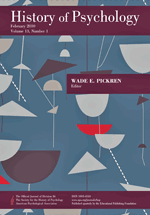
History of Psychology
Exploring the Evolution of Minds and MethodsHistory of Psychology, published by the Educational Publishing Foundation of the American Psychological Association, is a leading journal that chronicles the evolution of psychological thought and practice, serving as a vital resource for those interested in the historical dimensions of the discipline. With an ISSN of 1093-4510 and an E-ISSN of 1939-0610, this journal covers a wide array of topics that intersect both history and psychology, offering groundbreaking research and critical analyses from renowned scholars in the field. Given its commendable impact factor and recognition, it holds a prestigious Q1 ranking in History and a Q4 ranking in miscellaneous Psychology according to the 2023 category quartiles. The journal not only enhances scholarly discourse but also makes significant contributions to our understanding of the historical contexts that shape contemporary psychological theories and practices. Researchers, professionals, and students alike will find invaluable insights and context within its pages, making it an essential addition to any academic library. Access options are available through subscription or institutional purchase, facilitating engagement with its rich historical content that ranges from 1998 to 2024.